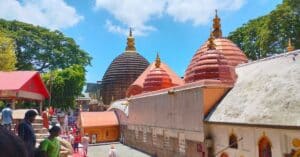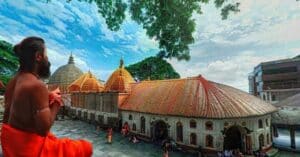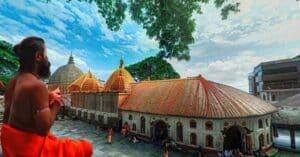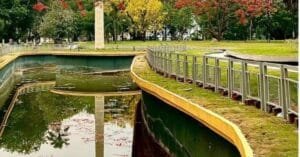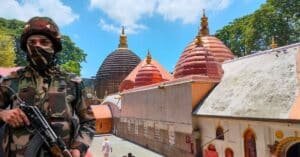Guwahati, the city of eastern lights, is known for its majestic temples that date back to pre-historic times. The temples of Guwahati are considered one of the oldest Hindu temples in India. Gauhati and its surroundings have famous temples like Kamakhya Temple, Umananda, Sukreswar temples, Basisthashram or the Basistha temple, Nabagraha Temple, Gita Mandir, and Balaji Temple developed within the city environment. Here is a detailed blog about temples in Guwahati, its history, travel tips and a guide to visiting temples of Guwahati.
History of Temples in Guwahati
Kamakhya Temple: Most Famous Temples of Guwahati
The Kamakhya Temple, situated on the Nilachal Hill in the western part of Guwahati city in Assam is one of the oldest of the 51 Shakti Peethas in India. It is one of the biggest temples of Guwahati. The temple complex consists of 11 temples; one main temple is surrounded by 1o other temples. The architectural layout of Kamakhya temple is mesmerising and quite advanced even by today’s standards. Engraved upon the walls of the temple are various Gods and Goddesses that add the minuteness of detailing in the architectural design.
One has to reach the temple by early morning at 5 am to get darshan (witness the sanctum sanctorum of the temple) by 10 am, that too through the purchase of tickets worth Rs 501. However, you can offer your prayers/offerings at other places as there are as many as 10 temples surrounding the main temple.
Festivals in Kamakhya Temple: Being the centre for Tantra worship this temple attracts thousands of Tantra devotees in an annual festival known as the Ambubachi Mela held in June every year. Another annual celebration is the Deodhani or Devadhwani Mela (Manasa Puja) held in August. Durga Puja is also celebrated annually at Kamakhya during Navaratri (September/October,) in the autumn. This five-day festival (Durga Puja) attracts several thousand visitors. The Shivratri festival held in March attracts a large number of devotees.
Best Time to Visit: Being a popular tourist destination in Northeast India, Kamakhya temple witnesses thousands of devotees every day. So, there is no lean phase from a tourist point of view. Expect a large crowd around the year. If you love a large congregation of devotees, visit Kamakhya temple during the Ambubachi mela (21st and 22nd of June) or Maha Shivratri (Mid-March). You would feel the vibe of a miniature Kumbh mela.
However, you need peace and devotion, so visit during the off-season, when there are no festivals according to the Hindu calendar. Visit Kamakhya temple during morning hours. Foggy Himachal hills, the view of the river Brahmaputra and the Guwahati city below the hill are worth a view.
Umananda Temple
Umananda Temple, situated on the picturesque Peacock Island in the Brahmaputra River, is a sacred abode dedicated to Lord Shiva. Built by the devout Shivaite Ahom King Gadhadhar Singha, this 300-year-old temple is nestled on the mountain known as Bhasmacala. The island itself is recognised as the smallest inhabited riverine island globally, offering a unique spiritual experience. Unlike other temples in Guwahati, this temple is not frequented by many tourists.
Best Time to Visit: It is said that a visit to Kamakhya should be followed by a visit to this temple in Guwahati. Maha Shivaratri is widely celebrated in Umananda. Monday is considered to be the holiest day in the temple. There is no rush in Umananda temple except during Maha Shivaratri in Guwahati.
To reach the Umananda Temple, one can embark on a ferry journey from Sukreswar Ghat, located near Panbazar in Guwahati. The ferry ride takes approximately 30 minutes, and there are both private and government boats available. Additionally, a cable car offers a scenic view of the temple from above, providing a unique perspective for visitors.
The journey involves around 300 steps to ascend to the temple, taking approximately 15-20 minutes. The normal boat ticket price is a mere 40 rupees for a round trip, making it an affordable and accessible pilgrimage destination. The ancient temples on Peacock Island boast a history spanning over 300 years, adding to the cultural and historical significance of the site.
Sukreswar Temple

The history of the Sukreswar Temple is associated with Saint Sukra, who regularly meditated and worshipped Lord Shiva at Sukreswar hill of Guwahati. According to the Kalika Purana (an ancient religious text of Assam), a temple existed at the location since time immemorial. This temple later was re-constructed in the year 1744 by the King of Ahom, Parramatta Singh. In the year 1759, King Rajeswar Singha redeveloped the temple making it accessible to the general public. The bank of the river on which the temple is located is used by the devotees for taking holy baths and performing other Puja activities.
Sukreswar temples of Guwahati are situated at the foothills of the Itakhuli Hills by the river Brahmaputra. One must enter the temple through the Janardan Devalaya Gate. Then you’ll find the steps to the Shukreswar Devalaya. You can also enjoy the riverside behind the temple, and in the evening, a majestic sunset can also be enjoyed.
The Sukreswar temple complex has two main shrines dedicated to Lord Vishnu and Lord Shiva. The temple complex also includes several other smaller shrines dedicated to various deities like Lord Ganesha, Goddess Durga, Lord Hanuman, and Navagrahas (the nine celestial bodies). The temple’s architecture reflects a blend of Assamese and Mughal styles, with intricate carvings and designs adorning its walls and pillars.
Timing of Sukreswar Temple and Best Time to Visit: Sukreswar temple is open throughout the year and can be visited from 5 AM till 9 PM. However, if you want a peaceful atmosphere and a great view, visit early morning or sunset hour. You can get the best view of the Sun over the Brahmaputra river.
Basistha Temple: Temples of Guwahati amidst Nature
The Basistha temple, located in the southeast corner of Guwahati city, is said to be the ashram of the sage Basistha, one of the Saptarishis (seven sages) of Hindu mythology. The temple is believed to be over 5,000 years old. There is still a cave in which the sage Basistha is believed to have meditated located 5 km inside the temple. The temple is located on the outskirts of the Garbhanga Reserve forest in Guwahati. The temple stands on the bank of the mountain stream Basistha, named after the temple.
The main temple is a small, domed structure, with a linga inside. There are also several other temples and shrines in the complex, dedicated to other Hindu deities.
Best Time to Visit: The best time to visit the Basistha temple is during the month of Sawan Month or Shravan Month (July-August). People also visit this temple during Chhath puja and during Maha Shivaratri.
Things to do: If you walk few miles away from the temple, you will find Ganesha temple crafted in huge stone to give the shape of elephant. Secondly, you can take a holy bathe in the basitha river flowing by the temple.
Nabagraha Temple:
The temple is not to be confused with other Navagraha temples of guwahati. Here is is the link its google location. The Nabagraha temple is situated on top of the Chitrachal Hill (or Navagraha Hill) in southeastern Guwahati. According to an inscription on the temple premises, the Ahom King Rajeswara Singha temple was rebuilt in 1752. Nabagraha temple is dedicated to the nine celestial bodies which are known as nabagraha in Hindu mythology. The temple enshrines nine Shivalingas, 9 Shivalinga representing 9 Graha with a Shivalinga at centre symbolising the Sun. The shivalingas represents planetary gods- Chandra (Moon), Mangala (Mars), Budha (Mercury), Brihaspati (Jupiter), Shukra (Venus), Shani (Saturn), Rahu (North Lunar Node) and Ketu (South Lunar Node) surrounding the centre most Surya (Sun).
Built in the old shikhara style architecture, the venerated temple is a popular pilgrim spot and is flocked by devotees day in and day out. Also, the temple premises are used as a research centre for astrology. In addition to the elegant edifice, elaborate inscriptions and interior decor, the temple complex offers stunning views of the Brahmaputra river and the Guwahati city below.
Best Time to Visit: The annual Navagraha Havan at Navagraha Temple in February includes sacred fire offerings, Vedic chants, and hymns. It seeks blessings from Navagraha, cleansing devotees of negativity, fostering spiritual growth, and well-being.
FAQs regarding Temples of Guwahati
Q: Who Built Sukreswar Temple of Guwahati?
A: Sukreswar was constructed in the year 1744 by the Ahom King Pramatta Singh. In the year 1759, king Rajeswar Singha redeveloped the temple making it accessible to general public.











